Discovering Top Japanese Dining Spots in Dubai
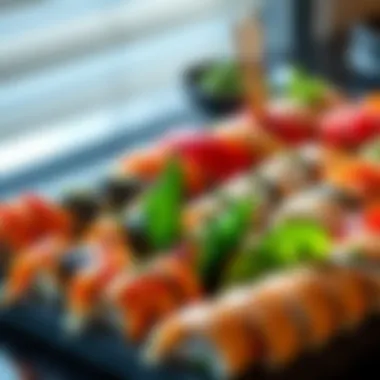
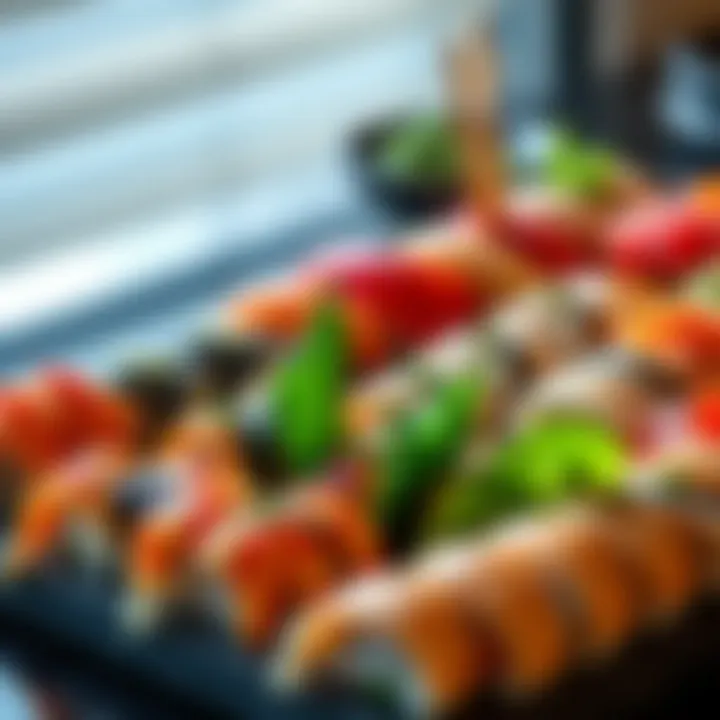
Intro
Dubai's food scene has become a melting pot of flavors and cultures, and one cuisine that has genuinely made its mark is Japanese. This wondrous blend of tradition and innovation has given rise to a variety of restaurants that serve up both authentic dishes and creative interpretations. Today, we take a closer look at these establishments that morph ordinary dining into an extraordinary experience, reflecting the essence of Japanese culture while resonating through Dubai’s multicultural spirit.
Japanese cuisine, known for its meticulous techniques and presentation, offers diners a feast for both the stomach and the eyes. Influenced by a rich heritage and thriving contemporary trends, restaurants in this corner of Dubai have something unique to offer. Whether you're a foodie on the hunt for the freshest sushi or a casual diner wanting to explore flavors that burst with umami, the city's Japanese restaurants are a destination worth visiting. This exploration takes us beyond just the dishes—into the ambiance, the chefs driving culinary artistry, and how this cuisine intertwines with the broader cultural fabric of Dubai.
As we journey through this article, prepare to be immersed in the characteristic charm of these restaurants. From serene izakayas to upscale dining spots, each venue tells its own story while contributing to the evolving narrative of Japanese cuisine here in the heart of the UAE.
Intro to Japanese Cuisine in Dubai
Japanese cuisine, famed for its precision and artistry, occupies a unique space in Dubai's multicultural tapestry. The city pulses with life, its culinary scene a reflection of its diverse population, and Japanese food adds a distinct flavor to this mélange. The infusion of traditional Japanese culinary practices with Dubai's contemporary dining ethos elevates the experience beyond mere sustenance to one of cultural exchange and appreciation.
Introducing readers to the realms of sushi, ramen, and kaiseki, this section will lay the groundwork for understanding the broader landscape of Japanese dining in Dubai. It examines what makes Japanese cuisine not only significant but also an essential part of the city’s restaurant offerings. There is a significance that overlaps between enjoying a meal at a Japanese restaurant and understanding the broader cultural narratives that inform our society.
Cultural Significance of Japanese Food
Japanese food is steeped in history and tradition, embodying values such as harmony, balance, and seasonality. The meticulous care that goes into every dish reflects a philosophy that prioritizes the seasons and the freshness of ingredients. This has profound implications in Dubai, a city known for its melting pot of cultures.
Embracing Japanese cuisine is as much about the food itself as it is about the rituals surrounding it. Diners are often drawn into an experience where they savor each bite mindfully, appreciating the flavors and textures. In many ways, enjoying Japanese food becomes a communal activity -- whether it's around a traditional tatami mat or a sleek sushi bar, sharing meals fosters connections and conversations.
Japanese food also speaks to the larger themes of globalism and cultural exchange. In Dubai, where cultures converge, one can easily observe Japanese culinary practices mingling with local traditions. Celebrity chefs and local entrepreneurs alike elevate these time-honored cooking techniques while ensuring that the authenticity remains intact.
Overview of the Restaurant Scene in Dubai
The restaurant scene in Dubai is nothing short of vibrant. With hundreds of options ranging from street food to Michelin-starred establishments, diners are spoilt for choice. Japanese restaurants, in particular, have seen a surge in popularity, marking their territory in every corner of the city. This growth is not merely coincidental but is indicative of a wider appreciation for the nuances of Japanese cuisine.
The city hosts a plethora of Japanese dining choices — from high-end sushi bars to family-friendly izakayas, each reinforcing the diverse culinary landscape of Dubai. As restaurants work to stand out, they incorporate elements that speak to their unique identity. From the ambiance to the menu, each Japanese restaurant weaves its own narrative, whether through a minimalist interior reminiscent of Japan or an energetic environment that captures the liveliness of Dubai.
Influential restaurateurs and chefs are continually innovating, resulting in a fusion of flavors and concepts. Some establishments are even going the extra mile to provide an immersive experience — think chefs in traditional garb preparing meals before your eyes, emphasizing performance just as much as culinary skill.
In summary, the interplay between traditional Japanese cuisine and Dubai's modern context creates a culinary landscape rich with opportunities for exploration, enriching not only the palate but also the cultural fabric of the city.
The rise of Japanese cuisine in Dubai reflects wider trends in globalization, emphasizing the importance of culinary diplomacy and cultural appreciation.
As we take a closer look at the intricate details that define this culinary experience, we encourage readers to engage deeply with the offerings of Dubai's Japanese restaurants.
Key Characteristics of Japanese Restaurants
Understanding the key characteristics of Japanese restaurants is crucial to appreciate not just the food, but also the entire dining experience they provide. These establishments often combine meticulous culinary craftsmanship with a serene ambiance that reflects Japanese culture. In a city like Dubai, where multiculturalism blooms, the unique aspects of Japanese cuisine stand out and add depth to the culinary landscape.
Traditional vs. Modern Japanese Dining
Japanese dining can be broadly categorized into traditional and modern approaches, each offering a distinct experience.
- Traditional Dining: This tends to focus on authenticity. Dishes are often prepared following age-old recipes and techniques. For instance, a traditional kaiseki meal comprises multiple courses, each element carefully crafted to harmonize not just in flavors but also in aesthetics. Traditional settings may include tatami mats and low tables, creating a genuine Japanese atmosphere.
In places like Dubai, you can find restaurants that adhere to these customs, offering a slice of Japan amidst the modernity. - Modern Dining: Here, creativity takes the front seat. Chefs experiment with ingredients and presentation, often merging Asian and Western culinary traditions. Imagine a sushi roll featuring local flavors like za'atar or a ramen bowl infused with spices popular in Middle Eastern cuisine. These innovative approaches cater to a younger generation’s palate while still nodding to traditional roots.
Combining these styles not only diversifies the offerings but also invites a wider audience to savor Japanese food.
Craftsmanship in Culinary Techniques
Craftsmanship is at the heart of Japanese cuisine, where each dish is not simply a means to satisfy hunger but a work of art. The techniques used can be quite intricate, requiring years of apprenticeship.
- Attention to Detail: Every aspect from slicing sashimi to garnishing a bowl of ramen is meticulous. Chefs often spend years perfecting their knife skills, understanding the precise angle and pressure needed to achieve the best texture and presentation.
- Balance of Flavors: Japanese chefs pay homage to natural flavors, emphasizing seasonal ingredients. The notion of umami—often described as the fifth taste, alongside sweet, sour, bitter, and salty—plays a vital role. It’s the subtle interplay of flavors that leaves diners wishing for more, making them return for another round.
"Craftsmanship is not just about cooking; it’s about telling a story through food."
- Cultural Techniques: Sushi making, for example, encompasses a variety of traditions, from selecting fresh seafood to rice seasoning, each requiring precision and expertise. Items such as tempura involve a delicate process of batter preparation and frying, showcasing the harmony between simplicity and complexity.
Defining Elements of Authentic Japanese Cuisine
Japanese cuisine, known for its artistry and subtle flavors, embodies much more than just the act of eating. The defining elements of authentic Japanese cuisine are essential for grasping its significance, especially within the vibrant food scene of Dubai. As a melting pot of cultures, the local culinary landscape thrives on such influences, making it vital to comprehend these key attributes that showcase the depth of Japanese dining here.
Seasonality and Fresh Ingredients
One cornerstone of authentic Japanese cooking is the use of seasonal and fresh ingredients. This principle, known as "shun" in Japanese, emphasizes that produce should be consumed at its peak ripeness and flavor. In practice, this means that a bowl served in a restaurant today could look radically different in a few months due to changes in ingredient availability. Chefs often visit local markets in Dubai, sourcing fish, vegetables, and fruits that elevate their dishes. This practice not only enhances flavor but also builds a connection between the cuisine and the local environment.

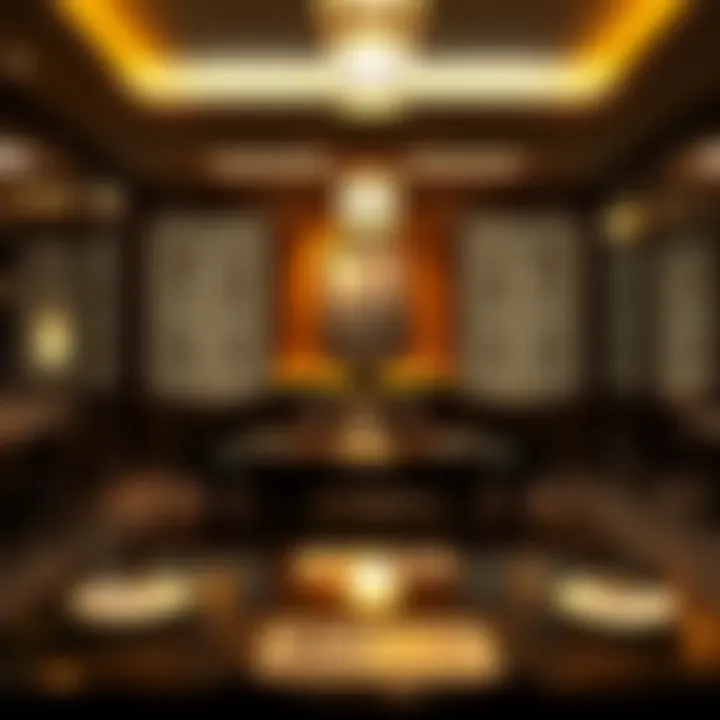
When dining out, seasonal menus can provide a fresh perspective on traditional dishes. For instance, during autumn, you might find dishes featuring chestnuts or persimmons, while summer might celebrate the flavors of cucumber and sweet corn. Such evolution keeps the dining experience exciting and reflective of nature’s rhythms. Therefore, restaurants emphasizing seasonality attract not just food enthusiasts but also conscious diners who appreciate the stories behind their meals.
Presentation as an Art Form
Presentation in Japanese cuisine goes beyond mere aesthetics; it is considered a vital part of the dining experience. In Japanese culture, the visual appeal of food reflects the chef's skill and reverence for their ingredients. This commitment to presentation can turn a straightforward dish into a feast for the senses.
Plates are treated like canvases, often including vibrant colors, contrasting textures, and thoughtful arrangements. Creating visually pleasing food respects the ingredients and enhances the diners' experience. For example, a simple sashimi platter may be garnished not just with edible flowers and herbs, but also laid out in a way that resembles a seasonal landscape. The play between color, shape, and design is a crucial aspect that sets authentic Japanese meals apart.
The act of preparing food is also ritualistic. Dishes are served with great attention to detail, and utensils often mirror traditional aesthetics, promoting a feeling of balance and harmony. This is where kintsugi, the art of repairing broken pottery with gold, finds its metaphorical application in cuisine. Just as repaired ceramics are celebrated, the preparation of food becomes a form of art that awakens appreciation in diners, making each meal memorable.
"The beauty of Japanese cuisine lies not just in the flavor but in the entire experience, where presentation speaks volumes about dedication and craftsmanship."
Top Japanese Restaurants in Dubai
When considering the culinary scene in Dubai, the spotlight often shines on the impressive array of high-end establishments. Japanese restaurants have carved out a niche of their own, blending tradition with innovation. This section delves into the significance of top Japanese restaurants in Dubai, highlighting their unique offerings.
The exploration of these restaurants provides insight into the synchronicity of culture and cuisine. With Japanese dining, it’s not just about the food; it’s a holistic experience. The ambiance, the service, and of course, the food itself, all come together to create memorable moments for patrons. Fine dining options appeal not only to epicures but also attract investors and property managers as they seek out quality culinary experiences that elevate the city’s reputation as a dining capital.
High-end Fine Dining Options
Dubai boasts several high-end Japanese dining venues that are nothing short of culinary artistry. Here are a few standout locations:
- Zuma: Renowned for its izakaya style of dining, Zuma combines traditional Japanese flavors with a modern twist. The chic interior and exceptional service complement an array of exquisite dishes, from perfectly crafted sushi to delectable robata grill selections.
- Nobu: This globally acclaimed restaurant harmonizes traditional Japanese techniques with Peruvian influences. Nobu not only captivates with its signature Black Cod Miso but also captivates with its luxurious ambiance, making it a favorite among celebrities and influencers.
- Tomo: Hidden in the Raffles hotel, Tomo embodies the essence of Japanese heritage. The dishes are crafted using authentic recipes and ingredients, providing a sincere taste of Japan in the heart of the UAE.
Each of these establishments offers a unique dining experience, marked by uncompromising quality in both ingredients and execution. The allure of fine dining resonates strongly with individuals looking for more than just a meal—it's about experiencing culture through cuisine.
Casual Dining Choices
Not every Japanese culinary experience requires a three-course meal at a lavish restaurant. Dubai also hosts a myriad of casual dining options that cater to those who desire excellent Japanese food without the formalities. Some notable mentions include:
- Tonkatsu: Well-known amongst locals for its tonkatsu, this casual spot has garnered a loyal following. The comforting fried pork cutlet served with homemade sauces is a hit, offering a satisfying meal without breaking the bank.
- Yumi: Situated in the vibrant area of the emirate, Yumi presents a trendy yet relaxed environment, perfect for after-work gatherings. The menu includes everything from sushi rolls to bento boxes that are fresh and vibrant.
- Sushi Art: Offering a unique approach to sushi, Sushi Art is ideal for millennials and younger crowds. It emphasizes creativity, allowing guests to customize their orders, which resonates with the Dubai culture of personalization.
These establishments create an inviting atmosphere and make authentic Japanese cuisine accessible to a broader audience, reinforcing the idea that quality dining does not always equate to a formal setting.
Hidden Gems Worth Exploring
For those with a more adventurous palate, Dubai has its share of hidden gems—intimate spots that capture the essence of Japanese culinary art.
- Katsuya by Starck: Though not entirely off the beaten path, Katsuya offers a unique blend of flavors that delight those in the know. The playful décor adds a lively element, enhancing the overall dining experience.
- Sushi Katsu: This smaller establishment prides itself on its no-frills approach to sushi. Many diners often miss it, but word-of-mouth highlights its authentic flavors and attention to detail.
- Tomomi: A small, family-run restaurant that specializes in regional dishes from Japan. The warmth of the service rivals the comfort of the food, making every visit feel like a welcomed homecoming.
These hidden treasures often boast loyal customer bases who return for the attentive service and delicious, authentic dishes. They are perfect examples of how the Japanese dining landscape in Dubai has expanded beyond the big names, appealing to those who appreciate simplicity and quality.
"In Dubai, Japanese restaurants encapsulate the city’s essence—melding tradition with modern flair, making the dining experience as diverse as its community."
As this section highlights, the blend of high-end dining spots, casual eateries, and hidden gems paints a rich picture of the Japanese culinary scene in Dubai. Each type serves its purpose, catering to different customer needs, ensuring that sushi lovers, ramen enthusiasts, or those just curious about Japanese cuisine find their place.
Signature Dishes to Try
When one thinks about Japanese cuisine, the first thing that likely comes to mind is the wonderful array of dishes that embody tradition and innovation. The signature dishes of Japanese restaurants in Dubai are more than just food; they represent the essence of a culture steeped in history and artistry. This section will illuminate why these dishes hold particular significance within the larger context of this article.
The variety of signature dishes available in Dubai's Japanese eateries not only showcases the culinary expertise of chefs but also highlights the subtleties of flavor and presentation that define authentic Japanese cuisine. Diners are invited to embark on a culinary journey where each dish tells a story. When you sit down to savor a plate of sushi or a comforting bowl of ramen, you are engaging in a time-honored tradition that speaks to both heart and palate.
Sushi and Sashimi Varieties
Sushi and sashimi are often hailed as the crown jewels of Japanese dining. In Dubai, the sushi you encounter is a vibrant blend of traditional Japanese techniques and local ingredients, creating a fusion that mirrors Dubai's own cultural mosaic.
- Nigiri: Hand-formed rice topped with a slice of fresh fish, nigiri is perhaps the most recognizable type of sushi, known for its delicate balance of flavors.
- Maki Rolls: These rolled sushi can be packed with an array of fillings—tuna, avocado, or even tempura shrimp—encased in a layer of seaweed, making for a delightful and visually appealing dish.
- Sashimi: This is the art of presenting raw fish in its pristine form. The quality of the fish becomes paramount here, and the skill of slicing it to perfection showcases the chef's craftsmanship.
The experience of enjoying sushi and sashimi is heightened in Dubai, where freshness is a badge of honor. Many restaurants proudly source their fish from sustainable fisheries and local markets, ensuring top-notch quality.
Ramen and Noodle Dishes
Ramen has weaved its way into the fabric of global comfort food, and in Dubai, it stands as a beloved staple of Japanese dining. The city's restaurants pull out all the stops with their ramen, offering various broths, from shoyu to tonkotsu, each unique in flavor.
- Tonkotsu Ramen: A rich, creamy broth made from pork bones, tonkotsu has gained a cult following for its hearty flavor and texture.
- Shoyu Ramen: This soy sauce-based broth adds a savory depth that appeals to both newcomers and purists alike.
- Vegetarian Options: Many establishments now cater to health-conscious diners with vegetarian or even vegan ramen, using innovative ingredients to replace traditional meat-based broths.
Beyond ramen, you may stumble upon dishes like udon and soba, each bringing their distinct texture and flavor profiles to the table. The versatility of these noodle dishes means there’s something for everyone.
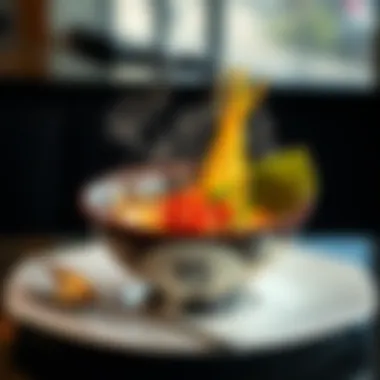
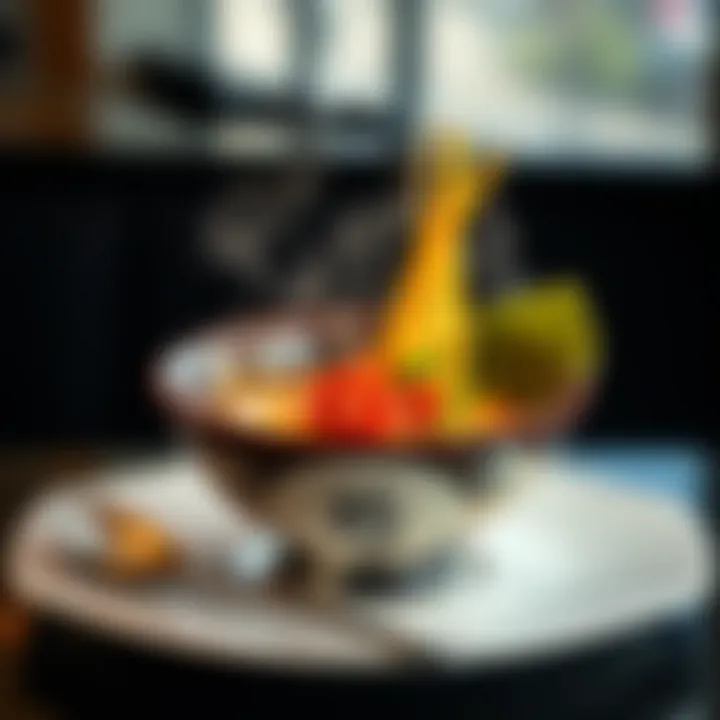
Traditional Desserts and Beverages
Desserts may not be the first thing that comes to mind when one thinks of Japanese cuisine, yet they play a vital role in delivering a sweet note at the end of a meal.
- Mochi: These glutinous rice cakes may be filled with anything from sweet beans to ice cream, and every bite is a delightful mix of texture and flavor.
- Matcha-based Treats: Concoctions like matcha parfaits or matcha cakes, draw on green tea’s bitterness and health benefits while providing a decadent finish to a meal.
- Sake and Shochu: No Japanese dining experience is complete without a sip of sake, a rice wine that pairs beautifully with your meal. Alternatively, shochu offers a different flavor palate, renowned for its versatility.
Traditional drinks such as green tea also often accompany meals, serving as a comforting way to cleanse the palate and enhance the overall dining experience.
Influence of Japanese Cuisine on Local Palates
The presence of Japanese cuisine in Dubai is not just a trend; it’s a growing phenomenon that reflects deeper cultural exchanges and evolving culinary preferences among locals and expatriates alike. The dynamic interplay between traditional Japanese flavors and the vibrant tastes of the Middle East has led to a unique fusion that continues to captivate palates.
Fusion Dishes and Modern Interpretations
One main aspect of how Japanese cuisine influences local tastes is through fusion dishes and modern adaptations. Sushi burritos, for one, have become a hit in Dubai's bustling food scene. This dish marries the art of sushi making with the concept of convenience food typical of urban lifestyles. Wrapped in seaweed and filled with savory ingredients, the sushi burrito caters to a busy demographic that values both flavor and speed.
Another example includes ramen burgers, which creatively integrates the classic Japanese noodle dish with a Western favorite. The combination not only intrigues buyers but also promotes the notion that traditional cuisines can evolve and be reinterpreted based on what local diners desire.
This blend of culinary styles makes dining out both an adventure and a satisfying experience. Additionally, the rise of izakaya-style restaurants, which serve smaller dishes meant for sharing, aligns perfectly with the social dining culture in Dubai.
Cultural Exchange Through Food
Moreover, food serves as an invaluable bridge between cultures. With Dubai being a melting pot of nationalities, the cultural exchange through food is significant. Japanese cuisine highlights meticulous craftsmanship, respect for ingredients, and presentation that resonates well with the discerning diner in Dubai. Chefs, often trained in traditional Japanese culinary schools, find themselves experimenting with flavors and textures from local UAE cuisine. For instance, using spices native to Arabic dishes in a teriyaki sauce or presenting sashimi with locally sourced ingredients akin to traditional mezze.
Restaurants often find their success rooted in this cultural dialogue. It can be seen in establishments that use Arabic herbs and spices to enhance the umami taste of traditional Japanese foods. This creative outreach does not merely broaden the culinary landscape but fosters appreciation and understanding among communities.
As culinary traditions intersect, diners are not just patrons but are part of a larger story, one where each meal tells tales of collaboration and adaptation. The influence of Japanese cuisine on local palates in Dubai is indeed a compelling narrative—one filled with innovation, tradition, and a commitment to enhancing the dining experience for all.
Dining Trends Affecting Japanese Restaurants
Health Conscious Dining Preferences
In a world where health takes precedence in culinary choices, Japanese restaurants in Dubai are increasingly adapting to the preferences of health-conscious diners. Traditionally, Japanese cuisine is already known for its fresh ingredients and relatively balanced meals, yet there's a noticeable shift towards transparency regarding nutrition. Many establishments now emphasize low-calorie options, organic produce, and dishes low in refined sugars.
For instance, sushi restaurants frequently offer brown rice alternatives, which are whole grain and lower in processed sugars. Additionally, you might find restaurants showcasing their calorie counts right on the menu. As awareness about dietary restrictions is on the rise, offerings targeting gluten-free and vegan patrons reflect this trend. The ability to cater to these preferences not only enhances the dining experience but also attracts a broader clientele, enabling Japanese restaurants to thrive in Dubai’s competitive market.
Sustainability Practices in the Kitchen
Sustainability has become more than just a buzzword; it’s a vital part of the culinary landscape. Japanese restaurants in Dubai are embracing this ethos by sourcing local ingredients and ensuring responsible fishing practices for seafood. The shift from imported ingredients to locally sourced produce lessens the carbon footprint of these establishments while also supporting local farmers.
The trend is evident in menus where seasonal vegetables are prioritized, reflecting the Japanese philosophy of shun, which emphasizes eating ingredients at the peak of their freshness. Furthermore, several restaurants are implementing waste reduction strategies, like composting and recycling where possible, and minimizing single-use plastics.
"Sustainable dining offers not only ecological benefits but fosters a community connected to food sources and practices."
Traveling even deeper into sustainability, some chefs are taking it upon themselves to create a dining experience that’s conscious of environmental impact, while also educating diners about why these practices matter. This effort not only improves customer loyalty but positions these restaurants as leaders in the movement towards greener dining in the heart of Dubai.
By observing these trends, it’s clear that the future of Japanese dining in Dubai closely intertwines with health awareness and a commitment to sustainability, reflecting broader societal changes and consumer values. This evolution enhances not only the dining experience but also aligns with the expectations of a more discerning clientele, such as investors and property managers, who value socially responsible dining options.
Experience and Ambiance of Japanese Dining
When one speaks of Japanese dining, it’s inaccurate to narrow the focus solely to the dishes served. The entire experience and ambiance play a crucial role in elevating a meal into a cultural journey. In the bustling environment of Dubai, the essence of Japanese restaurants is multifaceted, encapsulating not just culinary practices but also an immersion in aesthetic values and social norms. A seamless blend of taste, sight, and spirit enhances the allure of dining out, especially when it’s rooted in such a rich heritage as Japan’s.
Interior Designs Reflecting Japanese Aesthetics
Japanese aesthetics in dining areas are unmistakable; every corner reflects centuries of tradition and calming minimalism. Think of bamboo wood used in structural elements, delicate paper screen doors known as shoji, and the subtle interplay of light and shadow that guides guests into tranquility. It’s not just about dining, it’s about creating an atmosphere where the simplicity resonates with the complexity of flavors.
Restaurants like Zuma and Nobu demonstrate this beautifully. At Zuma, the dark wooden tables are lined with fresh flowers, fostering a connection with nature that is integral to Japanese design philosophy. Also, the concept of wa, or harmony, is palpable here as guests are encouraged to enjoy their food in quiet reflection, akin to an ancient tea ceremony.
Similarly, restaurants like Tamoto and Tomo emphasize the importance of space. The layout often features intimate booths, inviting guests to share their meals while maintaining personal space. These designs don’t just enhance aesthetics; they also present a framework for traditional Japanese social etiquette, where interaction is both valued and understated.
Service Standards in Japanese Restaurants
The service in Japanese restaurants can feel like a performance—graceful, attentive, and respectful. It's common to experience what's known as omotenashi, a philosophy steeped in the concept of hospitality. This goes beyond mere service; it's an all-encompassing care for the guest’s needs before they are even expressed.
In many high-end Japanese establishments, waitstaff often undergo rigorous training to embody this philosophy. They learn not just about food but also about the nuances of customer interaction. For instance, at Morimoto, waiters bow slightly upon greeting and offer assistance at the slightest hint of hesitation. This is indicative of how deep-rooted cultural values influence how services are rendered.


In casual environments, like in some izakayas across Dubai, the service tends to be friendlier and more relaxed, yet still maintains that customary respect inherent to Japanese culture. Guests might find themselves enveloped in an atmosphere bustling with engaging laughter yet decorated with tasteful decor.
Ultimately, the interplay of service and design creates a holistic experience that transforms each meal into a cultural engagement, making dining at these establishments not just about the food, but about participating in an art form.
For more on the impact of design in hospitality, consider reviewing this resource Aesthetic Value in Dining or discussions on the cultural significance of service in Japan at Cultural Insights.
The Role of Chef and Culinary Expertise
In the realm of Japanese dining, the chef's role extends far beyond just preparing meals; it encompasses a deep-seated respect for tradition, technical mastery, and a commitment to presenting food as a form of artistry. This section aims to shed light on why culinary expertise—specifically, the role of the chef—is pivotal for the success of Japanese restaurants in Dubai.
At its core, Japanese cuisine is revered for its attention to detail and refined techniques, which requires chefs to cultivate a skill set that goes beyond mere cooking. They must be well-versed in the delicate balance of flavors, the seasonal availability of ingredients, and the aesthetic presentation of dishes. In Dubai's multicultural landscape, where various culinary traditions intersect, the chef's expertise becomes even more crucial. They act as ambassadors of Japanese culture, imparting knowledge and fostering appreciation of their culinary heritage among a diverse clientele.
Moreover, the influence of revered chefs can elevate a restaurant's status, drawing food enthusiasts and connoisseurs alike. A restaurant helmed by a celebrated chef often garners attention that transcends its menu. This impact not only increases footfall but also shapes the overall dining experience, reinforcing the establishment's reputation in a competitive market.
"A skilled chef is the heart of a restaurant, converting raw ingredients into a captivating experience that tantalizes the palate and delights the senses."
Profiles of Influential Japanese Chefs in Dubai
The culinary landscape in Dubai features several prominent Japanese chefs whose artistry and innovation have redefined traditional dining. Notable figures include:
- Chef Hiroshi Nakamura at Nobu – Renowned for his approach that combines traditional techniques with local influences.
- Chef Masaharu Morimoto – A celebrity chef whose fusion dishes inspire creativity and showcase meticulous craftsmanship.
- Chef Teppei Yamashita from Teppei Japanese Restaurant – Known for his sushi-making prowess, he emphasizes freshness and authenticity in his offerings.
These chefs do more than just create meals; they envelop diners in a narrative that connects the food with Japanese culture. Each menu item becomes a chapter, each dish a story that unfolds with flavors and artistry.
Training and Qualifications for Culinary Excellence
Achieving culinary excellence demands rigorous training and a solid foundation in the art of cooking. Japanese chefs often undergo a highly structured education process, which includes:
- Formal Culinary Education: Attending esteemed culinary schools in Japan or globally recognized institutions ensures a comprehensive understanding of cuisine.
- Apprenticeships: Many chefs begin their careers as apprentices under experienced masters, often enduring years of rigorous practice to refine their skills and learn the nuances of Japanese cooking.
- Continuous Development: Industry trends and tastes evolve, and successful chefs stay updated through workshops, tastings, and culinary journeys to improve their craft.
The respect for technique, from the delicate art of sushi-making to the meticulous crafting of a ramen broth, is mediating achieved through years of dedicated training and practice. In Dubai, where discerning diners seek authenticity layered with brilliance, the role of trained chefs becomes paramount in not only creating amazing meals but cultivating a rich, immersive experience for each guest.
Future of Japanese Dining in Dubai
As Dubai continues to evolve into a global culinary hotspot, the future of Japanese dining is poised to shine even brighter. This section underscores the significance of the topic, focusing on various elements that influence the trajectory of Japanese cuisine within this dynamic city. A combination of cultural appreciation, innovation, and market demand drives the changes in the dining landscape. For discerning investors and property managers, recognizing these shifts is crucial as they directly correlate to enhancing real estate values and ensuring advantageous property investments.
The influx of expatriates and tourists not only fosters a multicultural environment but also fuels the appetite for diverse culinary experiences. Japanese cuisine, with its meticulous presentation and rich flavors, is increasingly appealing to both locals and visitors alike. This rising interest paves the way for new culinary hubs, innovative dining concepts, and perhaps even pop-up restaurants that reflect the latest trends.
Emerging Trends to Watch
A keen eye on the emerging trends in Japanese dining can reveal opportunities that may enhance investment potential. Notable trends that have been cropping up include:
- Sustainable Sourcing: Diners are becoming more health-conscious and environmentally aware. Restaurants are emphasizing locally sourced ingredients and sustainable seafood practices. This practice not only aligns with global sustainability efforts but also appeals to profit-driven consumers.
- Interactive Dining Experiences: Establishments are integrating technology and personalization into the dining experience. Features such as custom sushi building, cooking classes, or chef-led tastings are rising in popularity, earning restaurants a loyal patron base.
- Vegan and Plant-Based Options: As dietary preferences shift towards plant-based diets, several Japanese restaurants are innovating dishes that cater to vegan consumers without compromising authenticity. Expect more creative interpretations of traditional dishes using vegetables and plant-based alternatives.
"The shift in consumer preferences signifies a possible future where traditional Japanese cuisine adapts to meet modern demands, creating a fusion that respects roots while extending branches."
Expansion of Japanese Cuisine in the Region
The expansion of Japanese cuisine in Dubai is no longer just a trend but more of a growing phenomenon. Not only are existing restaurants evolving, but new ventures are also sprouting up across the region. Factors influencing this expansion include:
- Cultural Events and Festivals: Events centered around Japanese culture are drawing in crowds. These events often include food stalls featuring authentic bites that generate interest in Japanese cuisine, prompting new restaurants to consider targeting these metropolitan diners.
- Collaboration with International Chefs: Fusion concepts that blend various culinary styles with Japanese cooking are gaining traction. Collaborations with international chefs can lead to exciting menus that draw in a wider customer base.
- Strategic Location Choices: Establishments are positioning themselves in high-footfall areas, such as luxury malls or business districts, ensuring that they capture both local clientele and tourists.
The future of Japanese dining in Dubai looks promising, with these trends paving the way for a delightful and enriched culinary journey that intrigues taste buds and influences consumer behavior. Investors and property owners should remain attuned to these trends as they navigate the evolving landscape of dining within the city.
Epilogue
The realm of Japanese dining in Dubai is as multifaceted as the city itself. Through this exploration, we’ve seen how Japanese restaurants are not merely about food; they embody a cultural experience that merges tradition with modernity. Each dish tells a story, whether it’s the delicate artistry of sushi or the hearty warmth of ramen. Attending to the sensory elements like aroma, presentation, and texture enhances the dining experience, making it memorable for patrons.
Recap of Japanese Dining Highlights
As we wrap this exploration, it's essential to revisit key aspects that make Japanese restaurants in Dubai stand out:
- Diversity of Offerings: From high-end fine dining to casual eats, Dubai's Japanese restaurants cater to a wide range of tastes.
- Signature Dishes: The sushi and ramen choices especially showcase the authenticity of Japanese cuisine, crafted with an emphasis on freshness and flavor.
- Chef Expertise: A look into the careers of influential chefs reveals their pivotal role in shaping and maintaining Japan's culinary presence in the emirate.
- Cultural Significance: The interplay between culinary art and cultural narratives gives a deeper understanding of what Japanese dining represents in Dubai.
This summary reflects the vibrancy and sophistication of Japanese cuisine that continues to evolve within the UAE.
The Lasting Impact of Japanese Cuisine in Dubai
Japanese cuisine has carved a niche that transcends mere gastronomy in Dubai's diverse culinary scene. The impact is observable in various facets:
- Culinary Fusion: Influences from Japanese methods and ingredients have led to intriguing blend dishes that capture local flavors while preserving authenticity.
- Cultural Engagement: This cuisine has fostered connections between the local populace and Japan, creating a dialogue that goes beyond food, including cultural fairs and culinary events that celebrate the Japanese heritage.
- Community Building: Japanese restaurants often serve as social hubs, where individuals from different walks of life come together over shared meals, fostering community connections.
In essence, the enduring essence of Japanese cuisine in Dubai goes beyond culinary enjoyment; it enriches the multicultural fabric of the city, offering an ongoing narrative that continues to unfold through each new culinary venture.















